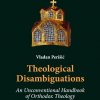Sermon on Sunday of Orthodoxy at Pan-Orthodox Vespers, St George Antiochian Church, Cicero IL, (a suburb of Chicago), March 13, 2022
Bishop Maxim (Vasiljevic) of Western Diocese
Your Eminences, Your Graces, dear brothers and sisters,
It is a joy to be here, united together in prayer on this special day celebrating the victory of truth and restoration of icons. Together, we have begun our Lenten journey with a week of prayer, fasting, and worship, seeking to strengthen our faith and renew our promise to God and His good will, His eudokia. Today, the inaugural week of Great Lent culminates in the celebration of the Sunday of Orthodoxy, a commemoration of the triumph of the true Faith with the final restoration of the Holy Icons to the churches in the year 843.
Significantly enough, our Orthodox Church has chosen the commemoration of the Seventh Ecumenical Council to be the Sunday of Orthodoxy. As is well known, this Council dealt with the issue of Icons, but it did not put forth any propositional definition of the faith. In declaring, “This is the faith of the Fathers; this is the faith which has sustained the oecumene,” the Council pointed to a form of “theology,” the icon, which was the liturgical experience of the community and required no subscription to conceptual or ideological statements. To be Orthodox means to enter in the universal liturgical concelebration and not to look for heresies around.
In today’s Gospel we’ve heard how Philip invited Nathanael by saying “Come and see”. He invited him to a certain place to see a face. But, what place and what vision did he have in mind? Where to come? And what to see? The feast of Orthodoxy, celebrated on the first Sunday of Great Lent, gives us the right answer.
Christ as a Person to see
This feast reveals to us the solution to the two-fold question that has historically surrounded icons and especially the icon par excellence, the icon of Christ. On the one hand, it addresses the complexity of describing God, Who by nature is indescribable (ἀπερίγραπτος), limitless, and infinite. And, on the other hand, it proclaims that it is theologically possibe to describe the indescribable (τὸν ἀπερίγραπτον) God. We know that it is impossible to make any adequate picture or description of God, for He is invisible and incomprehensible, and because “no one has ever seen God.”
However, “the only-begotten Son”, “who is the image of the invisible God” (Col. 1,15), in His Incarnation revealed the invisible God on a human face, as St. of Damascus paraphrased from the words of the forefather Jacob: I have seen the human form (face) of God, “and my soul has been saved” (Gen 32:31).
So, by inviting Nathanael to see, Philip had in mind the visibility in Christ’s person, Who is “the image of Father’s goodness, the true seal of revealing in Himself the Father,” as we’ve heard today in the eucharistic prayers. Since His incarnation, the Lord radiates the unfathomable eschatological newness of Love who once was lifted up to the Cross, descended to Hades, and was resurrected from the grave.
And yet, thanking to Christ, the icon reveals to us something else, an existential attitude and disposition.
Neighbor as Person to respect
When we stand before an icon, we do not kiss a mere photograph, but rather, the ultimate person of a Saint depicted and the Prototype which is Christ.
In the same manner, it is especially important for us to know and remember that when we stand with our fellow man, we should also see in him primarily his future restored, transformed and resurrected face, free of passions, overlooking his weaknesses and iniquities.
Therefore, during this season of Lent, we must pray, fast, give, forgive, and otherwise repent of all the ways in which we have allowed our passions to blind us from seeing every human person as a living icon of God.
The Church as a place of true iconicity
Now, what place did Philip have in mind when he said “come”? Where to come?
The place is the church. But, what place is the church today?
If we look at the church today what will we see? A community witnessing a surprising vision of life in God? Yes. But also, in some places the Church today looks sorrowfully divided on many levels.
This feast of Orthodoxy doesn’t invite us to be triumphalist.
As the late Bishop Atanasije of Herzegovina pointed out, “the mystery of the Church is found in this age-old and everyday miracle of history: that the Orthodox Church through all manifestations of human freedom, pass undefeated and unwaveringly faithful to the Truth of God, revealed to her and given to her once and for all by Christ.”
There is no real triumph in history? The victory is hidden in the Lord’s cross. “Through the cross a joy has come into the world.”
The God-man, in the words of an an Athonite Elder “reveals to us the true dimensions of glory in inglory, in self-emptying, for the sake of love. The dishonor of the Cross becomes glory because the Lord sacrificed Himself voluntarily for His friends.”
In prayerful pronouncing today’s Eucharistic Anaphora of St. Basil the Great, every Orthodox hierarch and priest on the East and the West—and I am sure all of them had in mind the suffering Ukraine—asked the Lord to “deliver every city and town, from fire, sword, invasion of foreign enemies, and civil war.”
We cannot celebrate this feast unless we humble ourselves and suffer with others. “If one member suffers, all suffer together; if one member is honored, all rejoice together,” says St. Paul (I Cor. 12: 25-26).
+ + +
May this feast of Orthodoxy contribute to the awakening of our awareness, and, through its theology, may it accelerate the respect of persons as icons of God in our world. That is where this feast leads us. This feast shows us that the Church has no definition of truth that simply satisfies intellectual curiosity; any aspiring definitions must describe a life experience, like the famous definition of Nicholas Cabasilas: “The Church is seen (present) in the holy mysteries.” And the icon is a dogmatic fact lived in the holy mysteries.
May we all then, today, fully aware of our rich treasure of faith in the holy icons, honor the memory of those who have handed down this precious heritage to us, and by so doing, solemnly rediscover this vision of life.
By recovering the true iconicity of creation, we can hope to find healing for our damaged sensibility, and once more, rededicate ourselves to our faith in Christ and to one another as we await the ultimate transformation of the world which has already begun through the Church.
This is central to our spiritual growth and this celebration today, as summarized in the historic Synodikon which we proclaim to one another and to the world.




